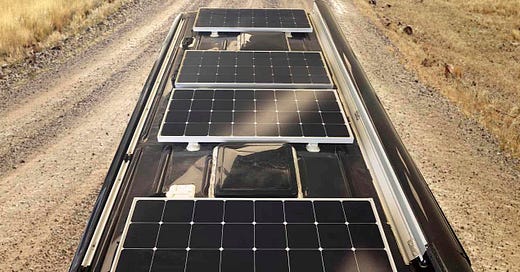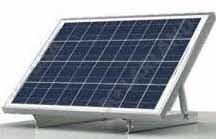Is 150-watts of solar panels enough?
A quick primer of how many solar panels you need to boondock
A question from the Hershey RV Show last year…
Hey Mike
One of the RVs I’m looking at has 150 watts of solar panels and a 100 amp-hr lithium battery. The salesman says that a 150-watt panel is plenty to keep my battery charged for a few days of dry camping. It also has a new 12-volt DC refrigerator, and I’ll need to use a CPAP machine at night. Is this guy correct, or is he blowing sales smoke up my skirt? —Alfonso
Dear Alfonso,
Ah, yes… This is a case of over-promising and under-delivering. Either he has no idea how solar works, or he’s just lying to make a sale. Let’s look at the numbers to see how this actually works.
How much battery storage does it have?
As I’ve noted many times here, a lithium battery can be discharged down to 0% State of Charge (SoC) thousands of times without damage. To calculate available energy we just need to multiply 12 volts times 100 amp-hrs to see that it equals 1,200 watt-hrs of energy.
Of course, if you had a 100 amp-hr flooded cell or AGM battery, they should only be discharged down to 50% State of Charge for best life, which would be 600 watt-hrs of energy.
How much energy will a 150-watt solar panel provide?
The general rule of thumb is that each 100 watts of solar will be able to provide between 300 and 400 watt-hrs of charging energy per day, depending on cloud cover, angle of the sun, and length of day. So if we multiply 1.5 times 300, that equals a minimum of 450 watt-hrs of charging per day, and possibly as much as 1.5 times 400 which equals 600 watt-hrs per day in a sunny climate. Let’s use 400 watt-hrs per day to account for real-world losses.
How fast will that charge the battery?
With everything turned off in your RV, that 150-watt panel will take at least 3 to 4 days of sun to completely recharge a 100 amp-hr lithium battery. That’s because 1,200 watt-hrs of battery divided by 400 watt-hrs per day of charging equals 3 days of time.
How much energy will that refrigerator use?
Of course, this depends on a lot of variables. But my experiments with 8- and 10-cubic-foot 12-volt refrigerators have shown that you’ll need around 900 watt-hrs per day to keep it running. So with a 1,200 watt-hr battery, it will drain the available power in a less than 2 days. Add a CPAP machine and a few lights and that 100 amp-hr battery could be dead by the first morning.
Can 150 watts of solar panels keep up?
No, because it can only replace 400 to 500 watt-hrs per day. So, that might extend the refrigerator by another half day of running. And that’s barely enough energy to replace the 500 watt-hrs a CPAP machine needs overnight!
So how much battery and solar do I really need?
If you want to dry camp (boondock) with a 12-volt DC refrigerator and CPAP machine for several days (let’s assume the CPAP machine will need 200 watt-hrs of energy per night), at a minimum you’ll need a second lithium battery, which is 200 amp-hrs or 2,400 watt-hrs of storage. But 400 amp-hrs would be better.
And you’ll also want at least 600 watts of solar, which could provide 2,400 watt-hours of charge per day. This would allow the sun to completely recharge your batteries in a day. Even if the sun doesn’t shine, you’ll still have at least 2 to 3 days of stored battery power.
Caveat emptor.…
Just like any other purchase, you’ll want to research the claims made by the salesperson. I’ll be doing more in-depth studies of solar panel and battery selection for boondocking, so stand by for more data. But in the meantime, I can tell you that 150 watts of solar panel and 100 amp-hrs of lithium battery storage will not be enough for your camping expectations.
OK, everyone. Remember that electricity is a useful and powerful force, so we all need to pay attention to safety precautions while using it.












This is our issue. With our truck camper we only have room on the roof for 2 90A panels (which we ordered from the factory as OE), and so our plan is to buy some portable panels to increase our charging capacity and allow the portables to be located in the sun and at the proper orientation. Next step will be swapping out the 2 275Ah 6V FLA batteries for Lithiums, but for now the extra $ spent on solar is probably a better investment.
My feeling has always been (once I dove into solar) to buy as much solar as you can afford and fit on your roof. Make sure your solar controller is MPPT for your best charging rate, and buy the best batteries you can afford (a good name brand). It's expensive to get into boondocking where you have few worries about power but well worth the expense if boondocking is going to be your thing.